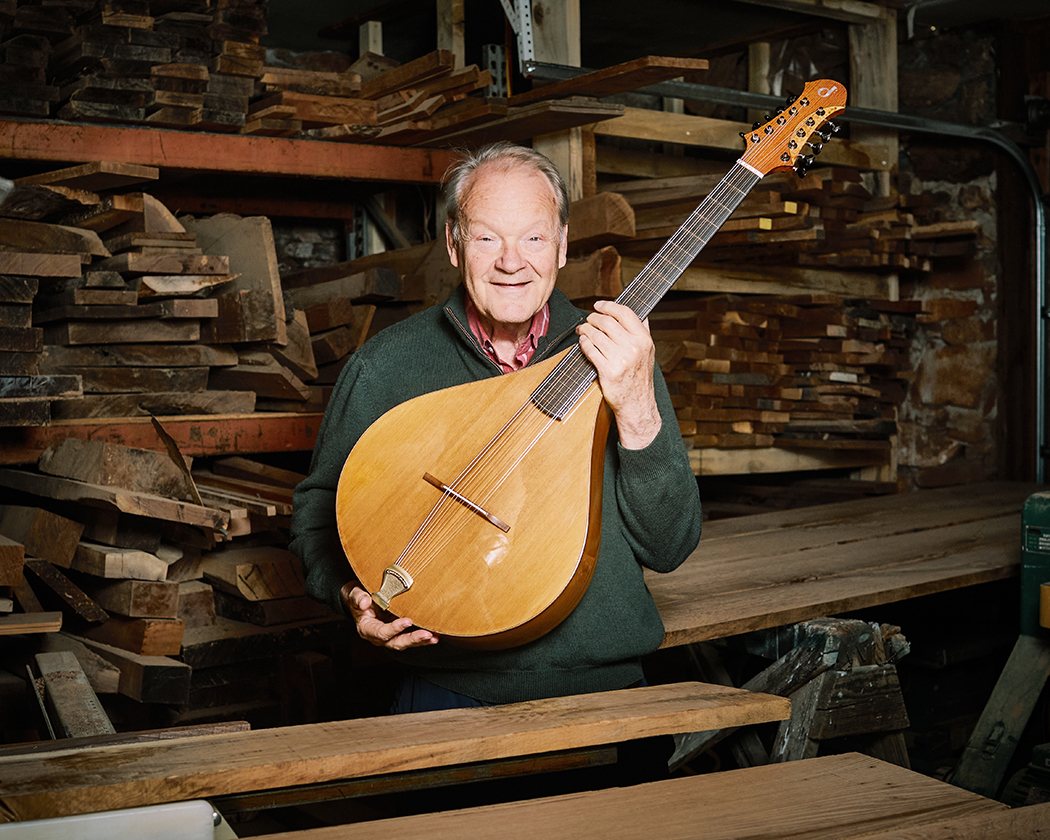Ralph Dammann and Ray Varona make instruments you’ve probably never heard of. Their specialty is the mandocello, a bigger, baritone version of the mandolin. But while mandocellos traditionally have four courses of paired strings, their version has five, spanning an even wider range than a guitar (from a low C, a third below the lowest string on a guitar, to the same high E). And that’s only one of their many innovations.
“We just don’t bother making anything that we don’t make significantly different from everybody else,” Dammann says. “Everything we do, we do it the way we do it.”
Dammann made his first instrument, an electric bass, in 1969. He was playing professionally in and around Washington, D.C., and he was looking for guidance on good bass technique. “With every other instrument, there’s a technique that’s worked out over years and years and years, centuries a lot of times,” he says. But with electric bass there was nothing. The only real advice on offer at that point was transferred over from the electric guitar, and it didn’t travel well.
Dammann finally found his foothold as he began studying double bass at American University, training under the principal of the Washington Symphony Orchestra. There he learned the technique he was looking for. But it was hard to put into practice on a standard electric bass, given the different orientation of the instruments.
So, naturally, he reinvented the electric bass. His version, which Dammann Custom Instruments still makes today, was rebalanced to stand upright like a double bass. He kept playing that bass throughout the ’70s.
The decades that followed took Dammann in different directions. He ran a successful construction company and built up a small cabinet shop. But he never abandoned the luthier’s art. He started making instruments for his son (who now plays bass professionally in Chicago), and Dammann’s cabinet shop slowly morphed into an instrument shop.
Things really picked up when he met Ray Varona in 2007. Varona was working with AmeriCorps at the time, but had been making instruments on his own since 2001. Varona has the exceedingly rare combination of an engineer’s mind and a musician’s ear, so Dammann worked hard to convince him to come on as head luthier.
“He’s a far better luthier than I ever was,” Dammann says. “He really understands a whole lot of the depth of it.” There are so many variables in the making of an acoustic instrument that affect the final sound. It can be almost impossible to tell what minor adjustment is responsible for what you hear—the kind of wood and the weight of it, the positioning of the sound port, and many more subtle factors still. Varona meticulously tracks all of these things, making each instrument slightly different from the last. “He’s always experimenting, but he never produces a bad instrument.”

Perhaps the most path-breaking of Varona’s experiments has been his “total control neck,” a now-patented mechanism for manually adjusting the action on an instrument—that is, for adjusting how far the strings are from the frets. If the action is too low, the strings will buzz against the frets. If it’s too high, fingering your chords becomes far more difficult. Over time, as the strings naturally pull on the joint between the body and the neck of an instrument, difficult and costly adjustments become necessary. Varona’s invention is the first really successful solution to the problem. Dammann hopes that in 20 years, you’ll see it on every guitar in the country.
Dammann and Varona have worked together now for 15 years, and the shop has grown tremendously from their partnership. They’ve made instruments for people all across the U.S.; they’ve made instruments for people in Britain and Turkey and France. Local musicians like Matthew O’Donnell (who plays Celtic music) and Jason Ring (who plays all varieties of Americana) can be heard playing Dammann instruments around town.
The key to their continuity and success is their refusal to be like anyone else, their devotion to making instruments in a way that no one else makes them. “That’s the part I’ve never been able to figure it out,” Dammann says. “Why, why, do you want to do the same little thing that everybody does?”
